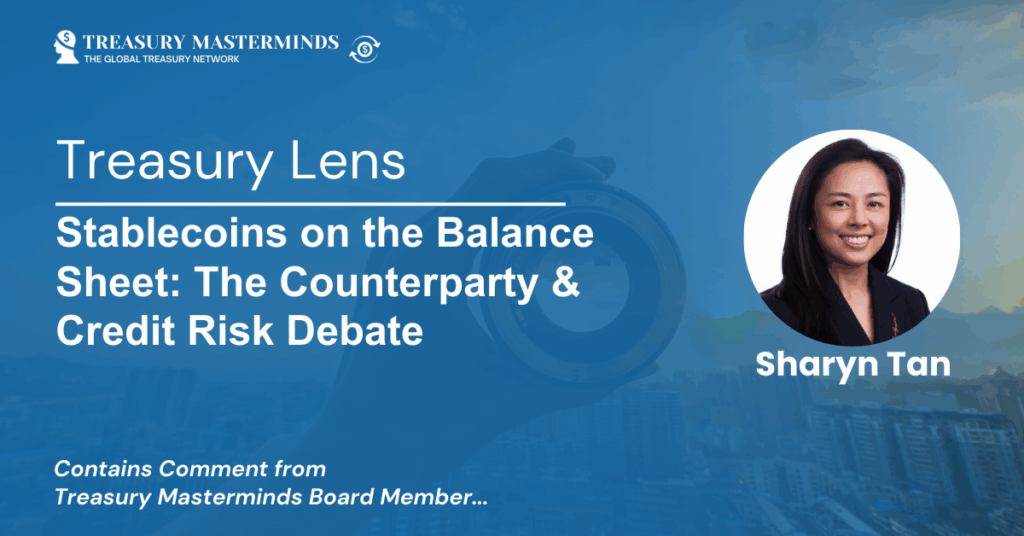
Stablecoins on the Balance Sheet: The Counterparty & Credit Risk Debate
Written by Sharyn Tan (Views are my own) Thesis: Stablecoins promise instant, low-cost, 24/7 settlement that traditional correspondent banking cannot match. But there’s a catch—you’re trading the credit risk of regulated banks for a mix of private issuers, offshore entities, and smart contracts. However, we’re not debating whether stablecoins will land on corporate balance sheets – they already have. The real question: Is the risk framework mature enough for this to be permanent? The Optimist Case – Why Treasurers Can Get Increasingly Comfortable The Skeptical Case – Why Treasurers and CFOs stay nervous A Treasurer’s Take: It’s not a binary choice between “all-in on stablecoins” and “never touch them.” Why not define tiered policies – something like: I suspect for most treasurers at large corporates, the “comfort threshold” for mass adoption looks like this: The bottom line Counterparty and credit risk have not disappeared with stablecoins — they’ve been reallocated. The question to ask is not “Is this as safe as a bank?” but “Do I understand this risk well enough to size it, diversify it, and get paid for taking it?” The industry is moving fast: better disclosure, better regulation (MiCA, Singapore, UAE, Hong Kong frameworks), better legal structures, and better on-chain transparency tools. Skeptics are right to demand more. Optimists are right that the tools to manage this risk already exist — and are improving quarter by quarter. The treasurer’s job hasn’t changed since the era of commercial paper and eurodollar deposits: understand the credit, diversify the counterparties, and stay within risk appetite. The medium changed. That discipline has not. So where do you stand? Are you evaluating to put stables on the balance sheet with a 2–5% limit, or still in the “observe only” camp? Also Read Join our Treasury Community Treasury Mastermind is a community of professionals working in treasury management or those interested in learning more about various topics related to treasury management, including cash management, foreign exchange management, and payments. To register and connect with Treasury professionals, click [HERE] or fill out the form below to get more information. Notice: JavaScript is required for this content.

Treasury’s Turning Point: What AI Actually Looks Like in the Real World
This article is written by our partner, Nilus “AI won’t replace you. But a person using AI might.” That quote set the tone at TMANY’s Future of AI in Treasury roundtable, co-hosted by Nilus and Redbridge. And it hit home. Because here’s the truth: AI in treasury is no longer theoretical. It’s not a slide deck or a distant roadmap. It’s already reshaping how finance teams forecast, reconcile, report, and act. At this roundtable, treasury leaders got honest about what they’re trying, what’s actually working, and what’s still standing in the way. The Shift Is Here, And It’s Personal Treasury leaders aren’t chasing buzzwords. They’re chasing hours, clarity, and confidence. What surfaced again and again was how everyday pain points are ripe for transformation, and how much time is lost trying to manually solve problems that AI is now equipped to handle automatically. Here’s what attendees want AI to fix first: These are not hypothetical use cases. They’re the daily friction points slowing down strategic work. And the message from the room was clear: if AI can lift the load, it should. Inside the Roundtable: What We Heard The roundtable, co-led by Nilus Co-Founder & CEO Daniel Kalish and Redbridge’s Bridget Meyer, was equal parts reality check and roadmap. It wasn’t about whether treasury should adopt AI; it was about how to get it right. Here’s what’s already in motion: But the room wasn’t blind to the hurdles. In fact, naming the barriers sparked some of the most tactical conversations: The most resonant insight? Treasury isn’t resistant to AI. It’s resistant to hype. Teams are ready, but only if the tools respect their complexity and prove ROI fast. Where Nilus Fits: AI That Drives Action At Nilus, we’ve always believed AI in treasury must do more than generate insights. It must drive action. That means: When you pair that with real-time cash visibility, actuals-to-forecast reconciliation, and continuous liquidity optimization,, you don’t just save time. You unlock faster, better decisions across the org. Strategic Takeaways for Treasury Leaders Here are five questions to bring back to your team this quarter: And if you’re not sure where to start: AI doesn’t have to be all-or-nothing. It starts with one well-scoped experiment. The Bottom Line The TMANY roundtable made one thing clear: Treasury teams aren’t waiting for a perfect roadmap. They’re learning, experimenting, and adapting together. If you want AI to work for treasury, it has to work with treasury. That means respecting the complexity of your data, the nuance of your decisions, and the stakes of getting it wrong. More from Nilus Join our Treasury Community Treasury Masterminds is a community of professionals working in treasury management or those interested in learning more about various topics related to treasury management, including cash management, foreign exchange management, and payments. To register and connect with Treasury professionals, click [HERE] or fill out the form below. Notice: JavaScript is required for this content.